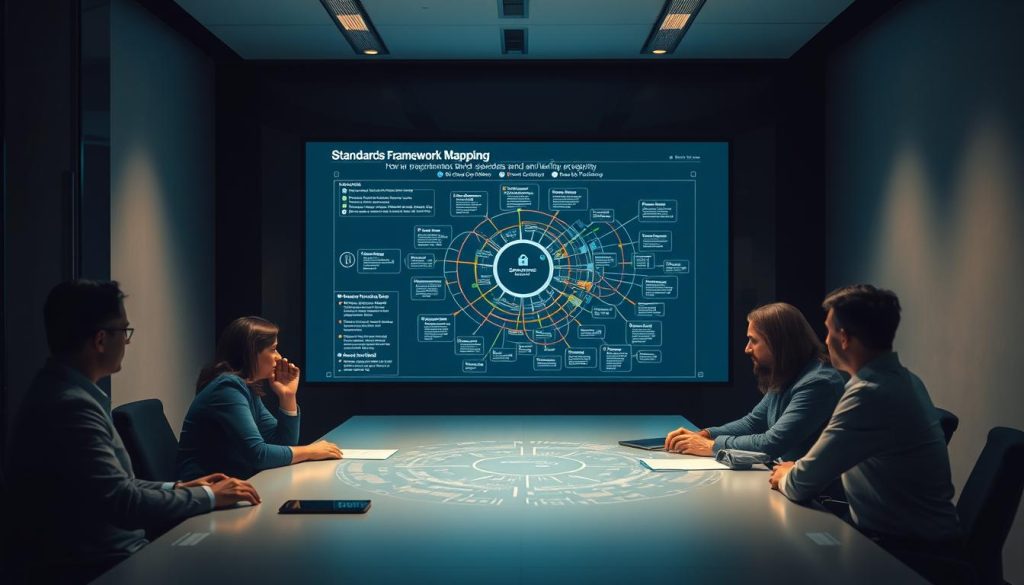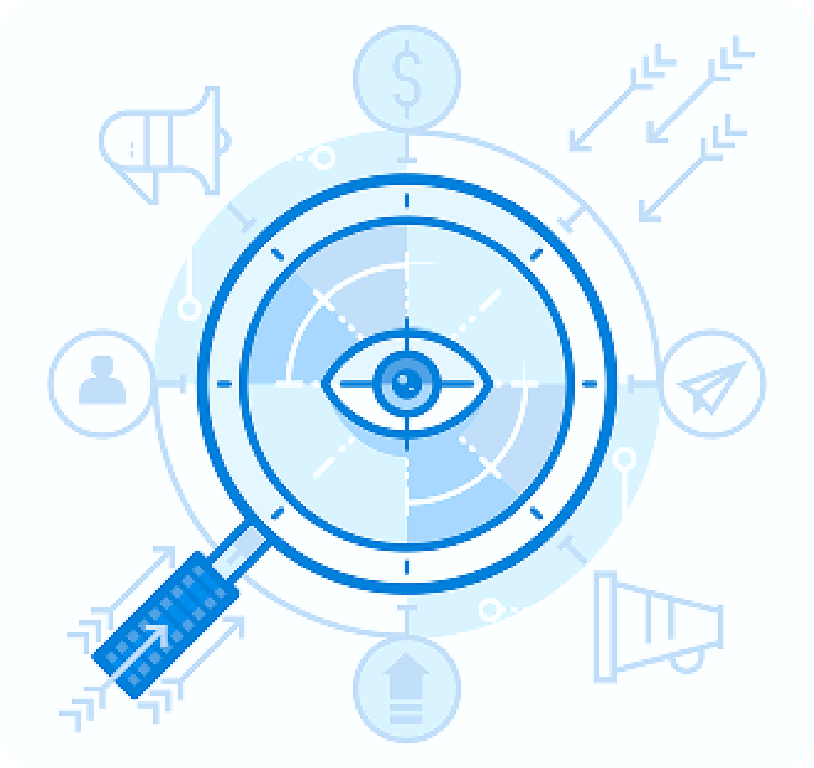We help U.S. enterprises translate standards into clear, measurable outcomes so executives and IT teams can prove readiness for audits and build trust with stakeholders.
This guide explains how a framework-driven approach differs from general security hardening and shows the practical steps that map requirements to your current state. We focus on priority areas first, create a realistic plan with time and cost estimates, and sequence remediation to limit disruption.
Our method turns a compliance gap analysis into an actionable report: requirements, current controls, adaptation paths, resources, timelines, and mitigation strategies. We include practical examples (PCI DSS and SOC 2) and show how automation accelerates continuous control monitoring and evidence collection.
As your collaborative partner, we scope the work with your organization, align controls to the chosen framework, and set milestones that demonstrate business benefits like reduced audit friction and improved efficiency.
Key Takeaways
- We convert standards into prioritized, measurable remediation plans.
- Framework-driven checks differ from general security work and target audit requirements.
- Reports include controls, timelines, costs, and mitigation steps for decision-makers.
- PCI DSS and SOC 2 examples show practical application and testing needs.
- Automation enables continuous monitoring, faster evidence collection, and lower audit effort.
Why gap analysis compliance matters right now in the United States
Proactive requirements checks convert uncertainty into clear remediation priorities for business leaders. U.S. organizations face increasing pressure as state privacy laws expand and sector standards evolve.
We recommend performing a review before new rules land, ahead of audits, after incidents, during mergers, and on an annual or biannual cadence. This routine uncovers missing policies and outdated response playbooks early.
Practical example: a cloud startup assessing GDPR found a missing data retention policy and an outdated incident response plan. Addressing those items early prevented findings and potential penalties.
Timely evaluation gives leaders the information needed to prioritize investments and sequence remediation that delivers business benefits. Aligning controls to a chosen framework increases predictability for audits and strengthens cross-functional accountability.
| Trigger | When to Act | Expected Outcome |
|---|---|---|
| New regulation | Before rollout | Requirements mapped; policy updates scheduled |
| Security incident | Immediately after containment | Controls tested; evidence collected |
| Mergers or major changes | During planning | Standards aligned; roles assigned |
We translate findings into actionable tasks and support execution so teams move faster toward being audit-ready. Learn more about our approach to a compliance gap analysis.
What is compliance gap analysis versus risk assessment?
We explain how a requirements-first assessment and a threat-centered risk review produce different outputs and complementary priorities.
Compliance gap analysis centers on mapping your existing controls to a chosen framework and identifying where requirements are unmet. This process yields a controls-to-requirements matrix and targeted remediation tasks.
Risk assessment evaluates threats, vulnerabilities, likelihood, and impact to rank weaknesses and recommend treatments based on exposure. The output is risk ratings and a prioritized mitigation plan.
Key differences: controls alignment vs. threat likelihood
- Requirements focus: validates design and operation of controls against standards.
- Threat focus: measures risk exposure and prioritizes fixes by impact.
- Audit expectation: auditors look for both controls mapping and a defensible risk process.
| Aspect | Requirements Mapping | Risk Assessment |
|---|---|---|
| Primary driver | Framework requirements | Threat likelihood & impact |
| Typical output | Controls matrix & remediation tasks | Risk ratings & treatment plan |
| How they work together | Ensures controls meet standards | Prioritizes the most critical weaknesses |
Operationalizing both reduces duplicate work: shared evidence, aligned scoping, and inclusion of SOC 2 (Trust Services Criteria) help bridge security and assurance for U.S. organizations seeking greater trust and audit readiness.
When to perform a compliance gap analysis
Timing matters. We recommend targeted reviews at predictable points so teams can fix issues before they become audit findings. Early checks lower cost and reduce disruption to operations.
Before new regulations or audits
Run a review prior to adopting new standards or an upcoming audit. This surfaces control discrepancies while there is time to remediate.
After incidents and during major organizational changes
Perform a post-incident study to map root causes to requirement failures and update policy and response playbooks.
Also reassess during mergers, cloud migrations, or platform overhauls. Large changes alter the control environment and need a fresh comparison to obligations.
On a recurring cadence for continuous compliance
Establish an annual or biannual cycle aligned with your audit schedule. Define steps, owners, and evidence collection so the process becomes routine.
| Timing | Trigger | Primary Action |
|---|---|---|
| Pre-implementation | New standard or regulation | Map requirements; plan remediation |
| Post-incident | Security breach or near miss | Root-cause review; update procedures |
| Transformation | M&A, migration, or major change | Re-scope controls; vendor due diligence |
| Recurring | Audit cycle (annual/biannual) | Continuous checks; evidence collection |
How to perform a gap analysis: a practical how-to guide
Start by setting scope and owners. Define systems, business units, and the framework you will use. Translate requirements into clear control statements and assign accountable people.
Define scope, frameworks, and requirements
We select the regulatory or voluntary standard (for example NIST or ISO) and list the assets in scope. This keeps work focused and measurable.
Assess people, processes, and technical controls
We review policies, interview control owners, and inspect configurations. Targeted tests validate operation of key controls.
Map obligations, collect evidence, and test controls
Map each requirement to current implementations. Build an evidence inventory that supports audit readiness and repeatability.
Identify gaps, rate impact, and document findings
- Run targeted tests (access reviews, encryption checks, vulnerability cadence).
- Rate impact by business context and requirement criticality.
- Produce a report with staffing, technology, timelines, and resource estimates.
We provide a template that helps identify areas across the organization, capture weaknesses, and outline management touchpoints for closure.
| Phase | Main action | Deliverable | Owner |
|---|---|---|---|
| Scope | Select framework; list systems | Control mapping | Security lead |
| Assess | Review people/process/tech | Evidence inventory | Control owners |
| Test & Report | Targeted tests; rate items | Remediation plan with timelines | Program manager |
Components of a strong compliance gap analysis report
A strong report turns technical findings into a roadmap that leaders can act on immediately.
Executive summary: a concise business-facing overview that lists prioritized requirements and the highest-impact areas for remediation.
Requirements and current controls: we detail the standard clauses in scope and present an inventory of existing controls mapped to each requirement. This lets management see which items meet standards and which need work.
Adaptations, time and cost: the report clarifies where controls can be adapted versus replaced. We provide time and cost estimates by activity, tied to business cycles and audit dates.
Resources and remediation plan: we recommend people, tooling, and external services required to execute the plan. The remediation plan includes milestones, owners, and acceptance criteria for objective tracking.
Challenges and mitigation: we document likely obstacles (legacy systems, staffing limits) and propose mitigation strategies that satisfy auditors without undue burden.
| Section | Purpose | Audience |
|---|---|---|
| Executive summary | Priorities and outcomes | Business leaders |
| Controls inventory | Mapped evidence and tests | Control owners |
| Technical appendix | Detailed findings and tests | Security teams |
Mapping your organization to leading standards and frameworks
We map your controls to multiple standards so leaders see where technical work supports business goals.
Our approach pairs NIST CSF for maturity and outcomes with NIST SP 800-53/800-171 for control rigor. We layer ISO 27001/27002 to anchor policies and processes and use SOC 2 Trust Services Criteria for audit readiness and trust.

NIST CSF and NIST 800-53/800-171 control alignment
We create traceable mappings from requirements to controls and evidence. Dashboards show tiering and where each control maps to a target maturity.
ISO 27001/27002 policies, processes, and control families
We advise which policies should anchor your ISMS and where technical safeguards must be the primary control. This reduces duplicated work across teams.
Trust Services Criteria for SOC readiness
We harmonize overlapping controls so one remediation can satisfy several standards. That approach streamlines soc compliance and shortens auditor prep time.
| Framework | Primary focus | Key output |
|---|---|---|
| NIST CSF | Maturity & outcomes | Tiered roadmap |
| NIST SP 800-53/171 | Control baselines | Technical control list |
| ISO 27001 / SOC 2 TSC | Policies & assurance | ISMS + audit evidence |
- We calibrate the mix by business context and data sensitivity.
- We embed management routines to keep mappings current.
- We prepare concise materials for boards and auditors.
PCI DSS example: conducting a focused PCI compliance gap analysis
A targeted PCI DSS assessment starts by isolating the cardholder data environment (CDE) and confirming where controls must operate.
We scope the CDE precisely to separate in-scope systems and data flows. This reduces audit exposure and focuses remediation on the right assets.
Cardholder data environment scoping and protections
We evaluate network segmentation, firewall rules, router baselines, and portable device protections.
We verify storage minimization, encryption in transit, and cryptographic key management to meet PCI requirements.
Vulnerability management, IAM, monitoring, and policy controls
- Vulnerabilities: test antimalware coverage and secure SDLC practices to lower exploitability.
- IAM: confirm least privilege, MFA, and physical access safeguards for sensitive assets.
- Monitoring & testing: validate protected audit trails, intrusion detection/prevention, and scheduled testing activities.
- Policy: align information security policy with Requirement 12 for governance, roles, and training.
We document findings with clear impacts and dependencies, sequence fixes by materiality, and coordinate evidence with acquiring banks and QSAs.
| Focus | Primary Action | Outcome |
|---|---|---|
| CDE scoping | Map flows and in-scope systems | Reduced scope, targeted remediation |
| Technical controls | Verify firewalls, encryption, IAM | Stronger protection for card data |
| Process & policy | Implement Req.12 governance | Documented roles, repeatable process |
SOC 2 gap assessment: steps, options, and outcomes
We conduct a SOC 2 readiness review that maps your security posture to the Trust Services Criteria and produces a clear remediation plan. This work prepares teams for initial attestation and annual renewals.
Scoping TSCs, analyzing controls, and prioritizing remediation
We help you scope applicable Trust Services Criteria—Security (mandatory) plus Availability, Confidentiality, Privacy, and Processing Integrity where relevant.
Our team reviews policies, access controls, system configurations, and incident response processes. We map findings to requirements and identify areas that need stronger controls.
Remediation is prioritized by audit criticality and business risk so the plan reduces audit friction and focuses limited resources on material issues.
Manual, third-party, and automated assessment approaches
Choose the approach that fits your resources and risk tolerance. Options include internal manual reviews, independent third-party assessments, and automated scans.
- Manual: deep, low-cost internal checks that require staff time and documentation.
- Third-party: higher assurance with auditor expertise for complex organizations.
- Automated: integrates with tooling to enable continuous monitoring, reduce evidence work, and speed recurring checks.
| Approach | Speed | Assurance |
|---|---|---|
| Internal manual | Moderate | Operational |
| Third-party | Slower | High |
| Automated | Fast | Scalable |
Outcome: a practical remediation plan with owners, timelines, and evidence requirements that helps management track progress and demonstrate trust to customers and auditors.
Prioritizing compliance gaps and building an action plan
We turn findings into a clear, risk-based plan that balances audit timelines, business impact, and available resources. This gives leaders measurable steps and helps teams reduce friction during remediation.
Risk-based prioritization, milestones, and ownership
We rank items by impact on operations and the audit timeline so the highest-risk issues get attention first. Owners are assigned across IT, security, and operations to ensure accountability.
- Plan and rank: translate findings into a prioritized remediation plan tied to requirements and controls.
- Milestones: set measurable acceptance criteria so progress is audit-ready.
- Testing: include verification steps to confirm fixes resolve root causes.
Budgeting, timelines, and minimizing operational disruption
We stage work to minimize downtime, align tasks with maintenance windows, and include quick wins to build momentum. Resource allocation balances internal capacity, external help, and automation to shorten time-to-value.
| Focus | Action | Outcome |
|---|---|---|
| Prioritization | Risk-based ranking | Targeted remediation |
| Scheduling | Staged implementations | Minimal disruption |
| Reporting | Single source of information | Clear management visibility |
We align the plan to your chosen framework and track organization current compliance posture against milestones. This approach prepares teams for SOC compliance and other attestations while keeping security improvements sustainable.
Using automation and monitoring to sustain compliance
Platform-driven controls let organizations detect drift and fix issues before they become findings. We design automated processes that keep security controls operating and provide a continuous view of posture for leaders.
Continuous control monitoring, access reviews, and evidence collection
We implement continuous monitoring to track control effectiveness, detect drift, and alert teams before audit dates or security issues arise.
Automated checks run hourly for critical systems, surface vulnerabilities, and trigger remediation tasks automatically. This shortens the detection-to-fix cycle and reduces manual work.
We also automate access reviews, evidence collection, and periodic testing of key controls so artifacts are stored and ready for reuse.
When to leverage platforms for reassessments and board reporting
We maintain an automated risk register and remediation workflows that keep tasks organized and accountable across the organization.
Integrations aggregate configuration checks, vulnerability signals, and user provisioning to reduce blind spots. Dashboards provide board-ready reporting with clear visuals on posture, resources, and trends.
| Platform feature | What it does | Executive benefit |
|---|---|---|
| Continuous checks | Hourly control verification and alerts | Faster fixes; fewer audit surprises |
| Automated access reviews | Scheduled recertification and evidence capture | Reduced manual effort; stronger IAM |
| Risk register & workflows | Auto-assign tasks and track status | Clear ownership; measurable plan progress |
| Board dashboards | Visual trends and resource requests | Better governance and funding decisions |
Policies and procedures that commonly reveal gaps
Many findings stem from policies that are outdated, missing key details, or not enforced across teams. These issues often surface during walkthroughs and sampling and increase regulatory and audit risk.
Data retention policy, incident response, and change management
Data retention policy: We verify scope, retention periods, and enforcement controls. Missing or vague retention rules cause records to be kept too long or deleted too soon. That raises data and regulatory risk.
Incident response: We review roles, runbooks, notification obligations, and testing cadence. Plans without runbooks or lessons-learned loops fail during real events and create audit findings.
Change management: We check approvals, segregation of duties, and evidence trails. Weak change controls lead to unauthorized changes and increase operational and security weaknesses.
- Review policy suites for completeness, currency, and alignment to frameworks, focusing on data retention policy scope and enforcement.
- Assess operationalization where policies exist but lack implementation, producing weaknesses during walkthroughs.
- Align policy language with control requirements to remove ambiguity and ensure consistent implementation across the organization.
- Recommend templates, resources, and a recurring review cycle tied to regulatory updates and business events.
| Policy Type | Primary Focus | Evidence to Collect |
|---|---|---|
| Data retention policy | Retention periods; storage controls | Retention schedules; storage config |
| Incident response | Roles; runbooks; notifications | Playbooks; test reports; post-mortems |
| Change management | Approvals; segregation; rollback | Change tickets; approval logs; audit trail |
We map each policy to controls and evidence for audits so teams can retrieve versions and demonstrate SOC compliance. This approach reduces effort in a compliance gap analysis and improves operational consistency.
Business benefits: cost savings, trust, and audit readiness
Identifying critical weaknesses early lets leadership direct resources where they produce the greatest return.
Our approach helps organizations avoid redundant investments and reduces the total cost of remediation. We quantify savings by focusing work on the most material findings and preserving budget for strategic priorities.
Key benefits include clearer audit timelines, faster evidence collection, and fewer questions during attestations. This shortens auditor cycles and lowers professional fees.
- We improve audit readiness with evidence-driven review that shortens audit cycles and reduces back-and-forth.
- We build trust with customers and stakeholders through transparent, repeatable practices.
- We help identify areas where small control changes mitigate outsized risk and elevate customer confidence.
- We provide reusable artifacts and resources that lower the cost of future assessments.
| Benefit | Business outcome | Management value |
|---|---|---|
| Cost savings | Less redundant spend | Clear budgeting |
| Trust | Stronger customer confidence | Better sales enablement |
| Audit readiness | Shorter attestations | Improved oversight |
Outcome: a practical remediation plan that positions the organization for growth, reduces weaknesses across policy, process, and technical controls, and embeds routines that sustain gains between audits.
Conclusion
Closing the loop means proving fixes work, locking evidence, and scheduling the next reassessment. We treat this guide as a living tool that lays groundwork secure operations and sustained audit readiness.
We encourage leaders to benchmark organization current compliance, close remaining actions, and record lessons learned—especially policy items like a clear data retention policy and improved incident response playbooks.
Our approach explains the differences between a gap analysis and a risk review and shows how combining both speeds remediation and strengthens resilience. Final comparison checks against standards and framework mappings validate scope, requirements coverage, and evidence completeness.
Next steps: assign owners, plan resources, add targeted testing, and apply automation for continuous control monitoring and board-ready reporting. We invite collaboration to tailor a plan that keeps controls in place and effective at scale.
FAQ
What is a compliance gap analysis and why does it matter now in the United States?
A compliance gap analysis compares your current security controls and processes to required standards and regulations (federal, state, or industry). Right now, the U.S. regulatory landscape is evolving rapidly across privacy, financial, and critical infrastructure sectors, so timely assessments reduce legal exposure, improve audit readiness, and protect customer trust.
How does a compliance gap analysis differ from a risk assessment?
A compliance review focuses on whether controls meet prescribed requirements and mapping to standards, while a risk assessment evaluates threats, likelihood, and potential impact on assets. Both inform strategy: the compliance review defines required controls; the risk assessment prioritizes where to strengthen protections.
When should we perform a compliance review?
Key times include before major audits or regulatory changes, after security incidents, during mergers or cloud migrations, and on a regular cadence (quarterly or annually) to maintain continuous alignment and evidence for auditors.
What are the first steps in a practical how-to compliance review?
Start by defining scope and applicable frameworks, inventory people/processes/technology, map obligations to controls, gather evidence, and test controls. Document findings, estimate remediation effort, and assign owners for follow-up.
What should a comprehensive compliance report include?
Reports should list regulatory requirements, current control mappings, recommended adaptations, time and cost estimates, resource needs, residual risk, and prioritized remediation actions with owners and timelines.
Which standards should we map to for enterprise readiness?
Common mappings include NIST CSF and NIST SP 800-53/800-171 for federal and supply-chain requirements, ISO 27001/27002 for management systems, and the AICPA Trust Services Criteria to prepare for SOC examinations.
How do we scope a PCI DSS–focused review?
Begin by scoping the cardholder data environment, documenting data flows, and validating segmentation. Assess vulnerability management, identity and access controls, monitoring, and relevant policies to ensure cardholder protections meet PCI standards.
What does a SOC 2 readiness assessment typically cover?
A SOC 2 readiness review scopes applicable Trust Services Criteria, evaluates control design and operating effectiveness, identifies manual versus automated gaps, and produces a prioritized remediation plan to achieve attest readiness.
How should we prioritize identified gaps and build an action plan?
Use a risk-based approach: rate each finding by likelihood and business impact, assign owners, set milestones, estimate budget and timelines, and plan phased remediation to minimize operational disruption.
Can automation help sustain compliance, and when should we adopt it?
Yes. Continuous control monitoring, automated evidence collection, and access review tooling reduce manual effort and improve assurance. Adopt automation when manual processes scale poorly or when frequent reassessments and board reporting are required.
Which policies typically reveal the most issues?
Common problem areas include data retention policies, incident response procedures, change management controls, and access governance. These areas often expose process gaps, evidence shortfalls, and inconsistent enforcement.
What business benefits can we expect from a thorough compliance review?
Benefits include reduced remediation costs through early detection, stronger third-party and customer trust, faster audit cycles, and improved resilience against incidents and regulatory penalties.
How long does a typical compliance readiness engagement take?
Duration varies with scope: focused thematic reviews (e.g., PCI or SOC controls) can take 4–8 weeks, while enterprise-wide mappings to multiple frameworks often require 8–16 weeks, including remediation planning and prioritization.
Who should be involved from our organization during the assessment?
Involve security and IT teams, risk and compliance leads, legal counsel, and business unit owners. Their collaboration ensures accurate evidence collection, practical remediation, and sustained policy adoption.
What evidence is typically required for auditors?
Typical evidence includes policy documents, configuration screenshots, system and network logs, change records, access review results, vulnerability scan reports, and incident response records demonstrating control operation.






